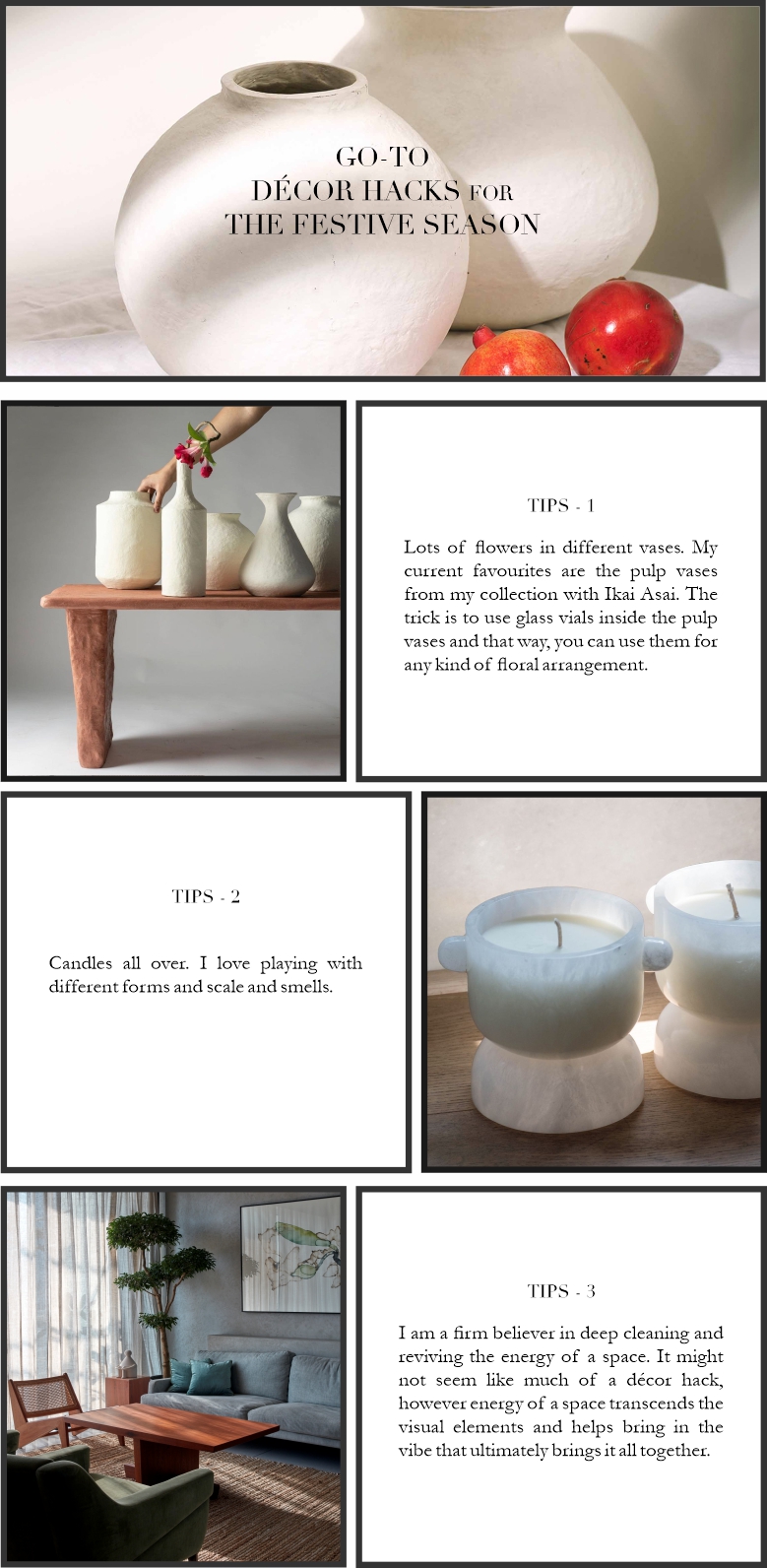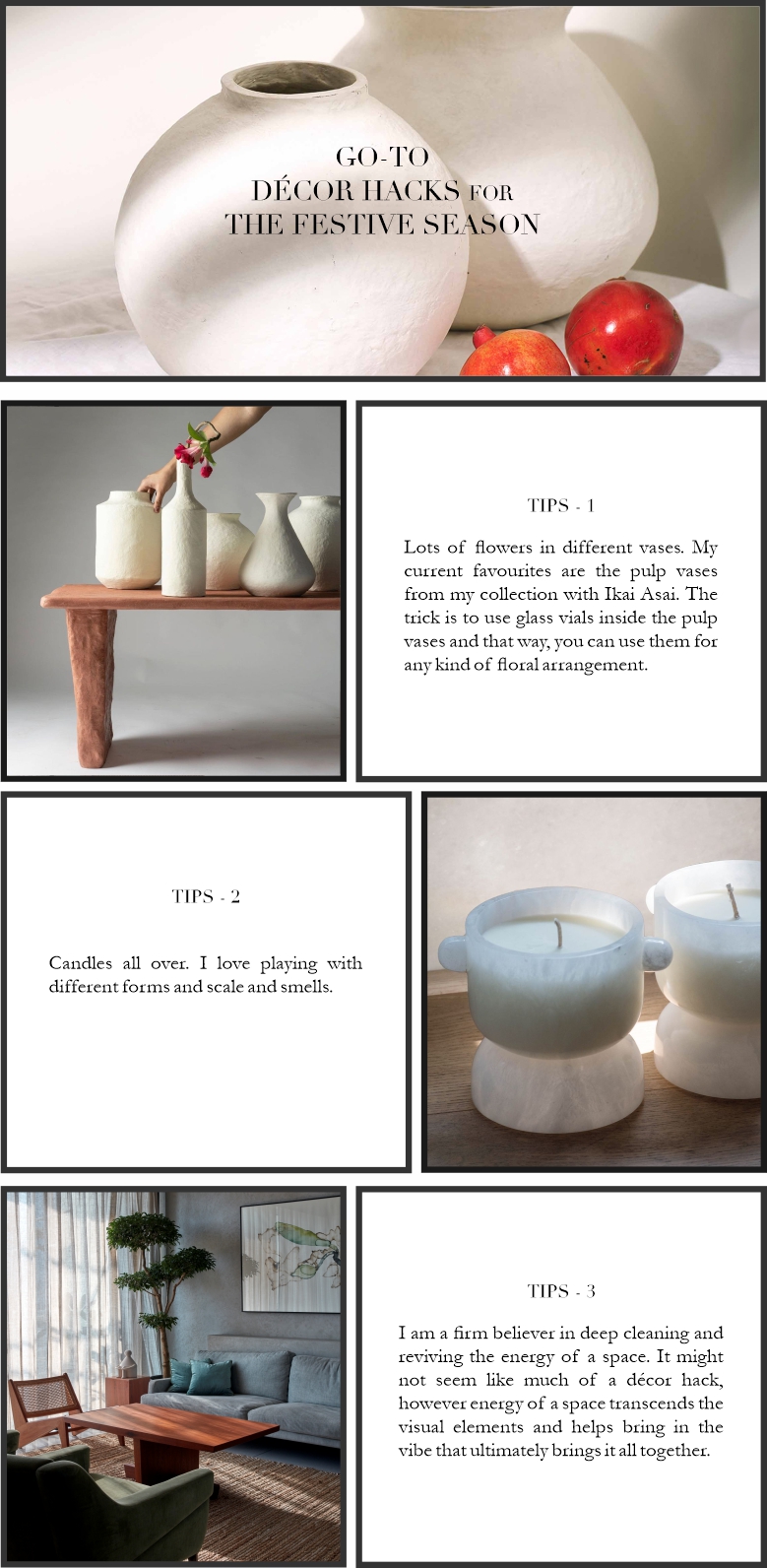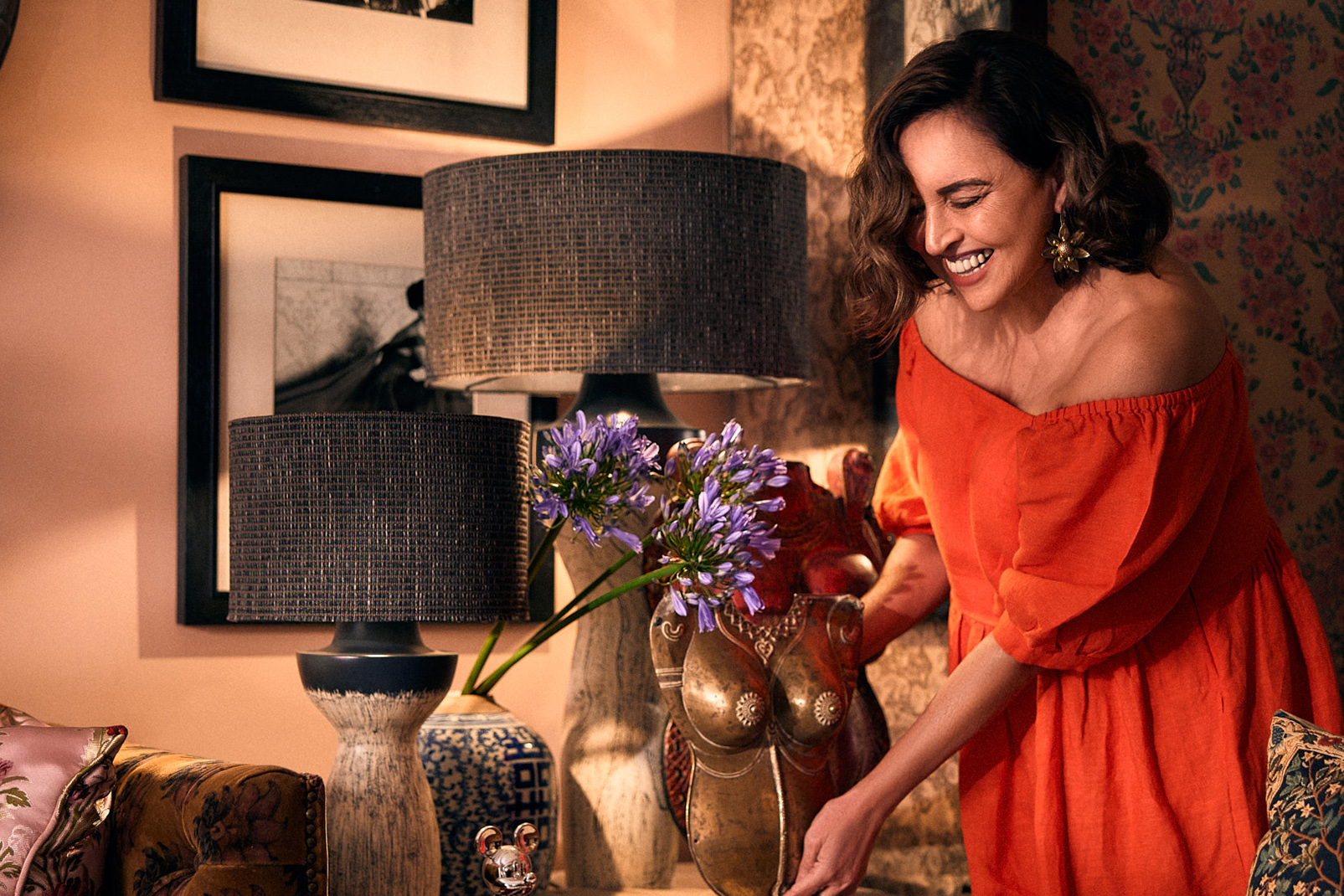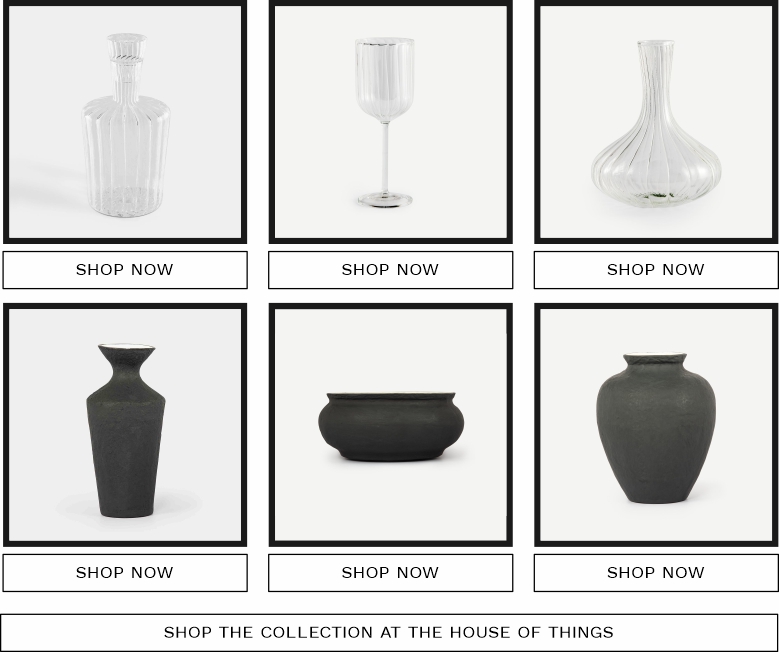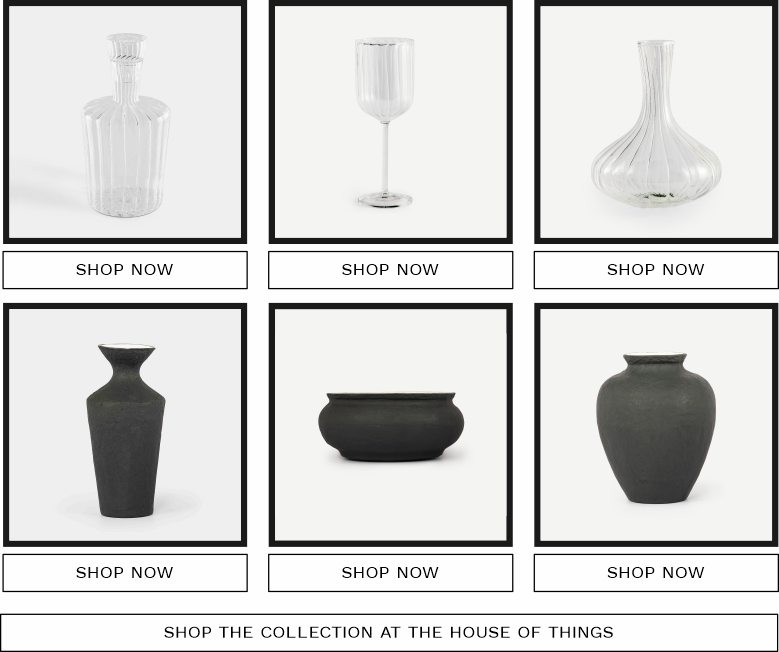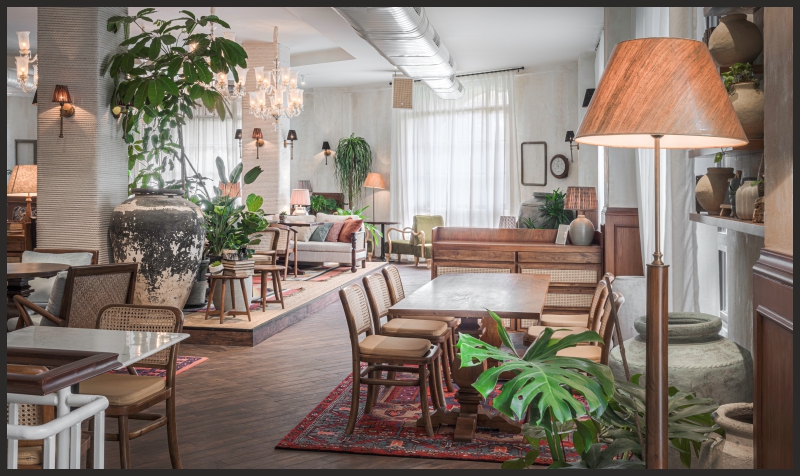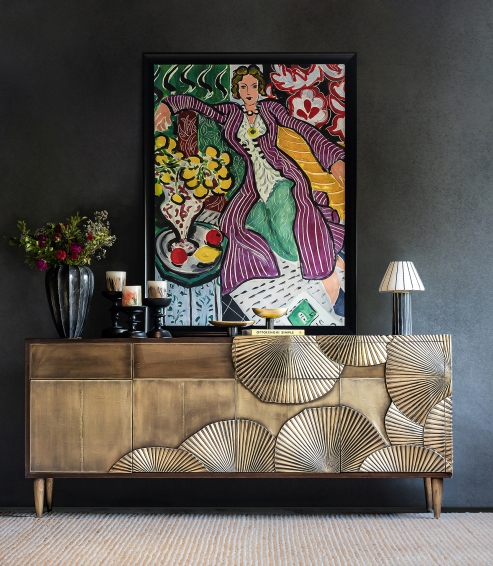We use cookies to make your experience better. To comply with the new e-Privacy directive, we need to ask for your consent to set the cookies. Learn more.
THIS SIMPLISTIC HOME BY RAVI VAZIRANI EMBRACES MINIMALISM AT ITS BEST
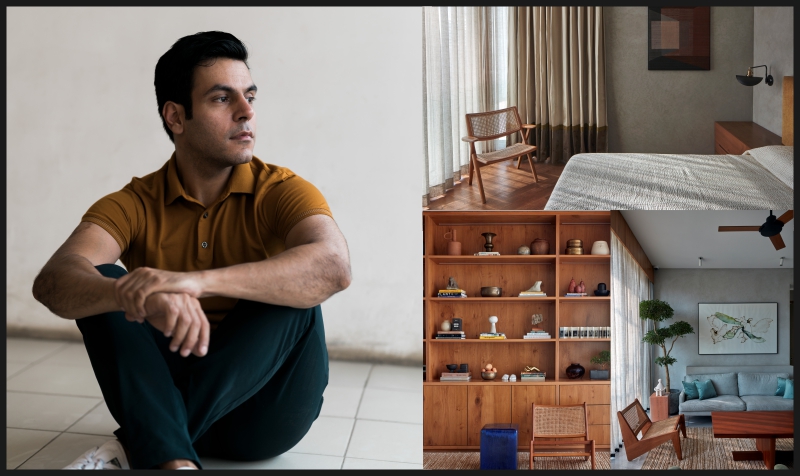
The brains behind some of the most beautiful homes seen in the country, interior designer Ravi Vazirani in fact, never studied design. Having honed his creative eye by serving as an Associate Style Editor with Living Etc, UK, subsequently acquiring a small but significant coterie of clients from the realms of retail, product, and residential design, the designer went on to establish the Ravi Vazirani Design Studio in 2010. The winner of the AD 50 Most Influential Designers Award in 2015, he has now actively been designing spaces for 7 years. Design is an intrinsic part of Ravi's daily life and he finds inspiration in everything he encounters, be it his immediate surroundings or his travels around the world. However, the one thing that ultimately inspires his artistry is his clients - their needs, aesthetics, and stories. That's why no two designs are alike, yet all of them have that unique stamp of workmanship and flair, which is all his own.

The private residence of Rishi and Ruchi Khajanchi breathes tranquillity and a Nordic-esque calmness achieved through a mix of the material palette and monochromes. All photos courtesy Pankaj Anand.

An exemplar of a good client-designer relationship, this 1500 sq. ft. apartment is poetry in minimal design with a focus on materials that blend into each other, allowing for the space to exude a sense of serenity and calm. The concept for Rishi and Ruchi Khajanchi’s apartment originates from a mindset of slow and conscious living, where all things are nurtured and there is a sincere effort to not over-stimulate the senses. The design intent was to create a monolithic space, that allowed for it to appear larger than what it is, a standard challenge of apartments in cities like Mumbai.

The apartment is a combination of three main materials, i.e. terrazzo, oak, and cement with a series of floor-to-ceiling structures which provide storage throughout the apartment, allowing for it to feel un-cluttered and in turn, visually calming and sparse.
Vazirani feels that the spaces he designs are an extension of what he personally seeks in life – calmness, warmth, and solitude. For this residence, he restricted to a muted material palette, and to allow the materials to flow from one to another seamlessly, so as to avoid any visual clutter. The home linen and upholstery was selected to blend in with the tone of the materials – while colour was only extended to the artwork, and the son’s bedroom.

The only burst of colour in the residence is the artwork in the living room by Apnavi Makanji – sourced from Tarq Gallery, and a structured burst of yellow, geometrically aligned with two adjacent walls.
A tactile combination of terrazzo tiles, concrete-finish walls, and lots of natural wood bring materiality and depth into the home. In the living room, a custom designed coffee table is paired with two wooden armchairs, offset by an earthy-hued carpet from Jaipur Rugs. A wood veneer clad floor-to-ceiling shelving unit covers one wall of the room, punctuated with artworks by Dayanita Singh, Aditi Singh, and many others.

The concrete and terrazzo palette continues into the dining space- dominated by a marble top dining table by Kunal Merchant, with dining chairs custom-made at Vazirani’s studio.

Wood veneer dominates the design in the guest bedroom as well, with a pink stone sculpture curated from Rajasthan adding colour and texture into the space. The wall behind the bed is entirely clad in fabric – showcasing another layer of textures without compromising on the minimalist aesthetic.
The master bedroom exhibits wooden floors, a material that leads from the door into the walk-through wardrobe. The wardrobe in fully mirrored – an infinity space with fluted glass doors leading into the bathroom. The focal point of the bedroom extends from the textile artwork by Netherlands-based studio x + I.

While the rest of the house has terrazzo tile flooring, the master bedroom has wooden floors, a material that carries over to the doorframe that leads into the walk-in wardrobe.
The design of the residence draws from a powerful pool of materials and forms to create a sensorial narrative, even as it reiterates a connection to the homeowners. Over a quick tête-à-tête with The House Of Things, Vazirani outlines the inspiration behind his new collection in collaboration with Ikai Asai, his go-to décor hacks for the festive season, and his top picks from our web boutique.

“The inspiration behind the Lila collection was the colours of Pondicherry, the people of Pondicherry and their culture. Since the collection is designed in the peak of the pandemic, I couldn’t physically travel to Pondicherry, hence we used images from travels of other people as a source of inspiration. It forced me to use a different perspective & experience Pondicherry & its culture through a borrowed lens and give it a voice which was our own. As a result, I chose to think of ‘Lila’ as a nomadic entity, who was currently based in Pondicherry, influenced by her surroundings, existing with these pieces.”



The brains behind some of the most beautiful homes seen in the country, interior designer Ravi Vazirani in fact, never studied design. Having honed his creative eye by serving as an Associate Style Editor with Living Etc, UK, subsequently acquiring a small but significant coterie of clients from the realms of retail, product, and residential design, the designer went on to establish the Ravi Vazirani Design Studio in 2010. He is the winner of the AD 50, AD 100, the EDIDA designer of the year amongst many, he has now actively been designing spaces for 12 years.. Design is an intrinsic part of Ravi's daily life and he finds inspiration in everything he encounters, be it his immediate surroundings or his travels around the world. However, the one thing that ultimately inspires his artistry is his clients - their needs, aesthetics, and stories. That's why no two designs are alike, yet all of them have that unique stamp of workmanship and flair, which is all his own.
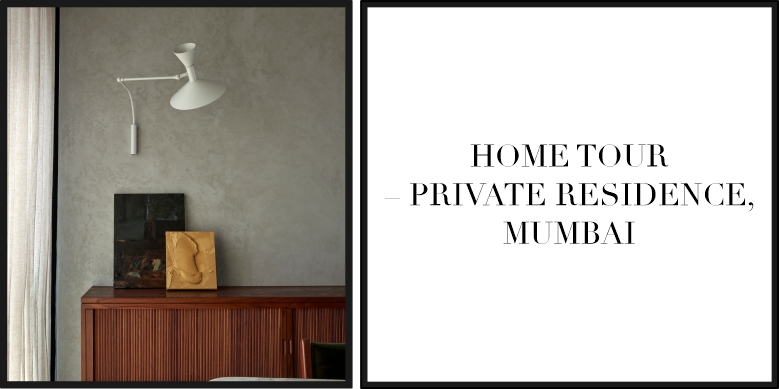
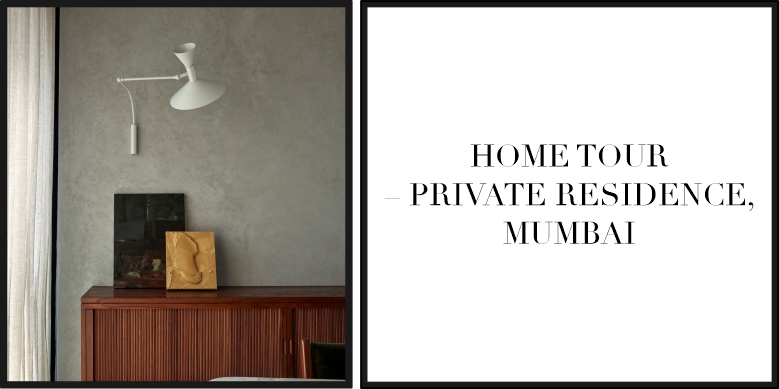
The private residence of Rishi and Ruchi Khajanchi breathes tranquillity and a Nordic-esque calmness achieved through a mix of the material palette and monochromes. All photos courtesy Pankaj Anand.
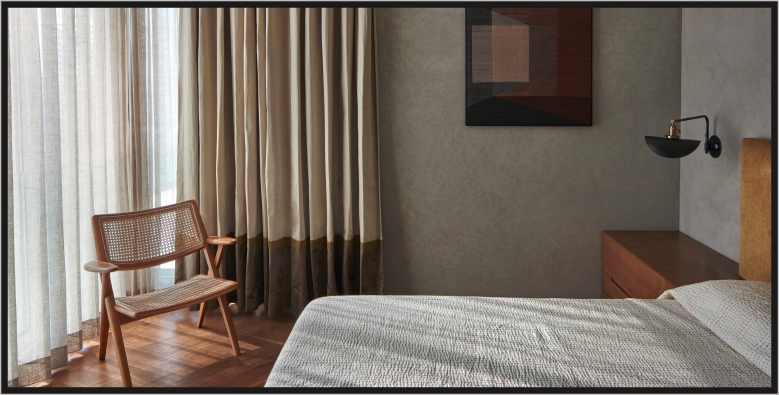
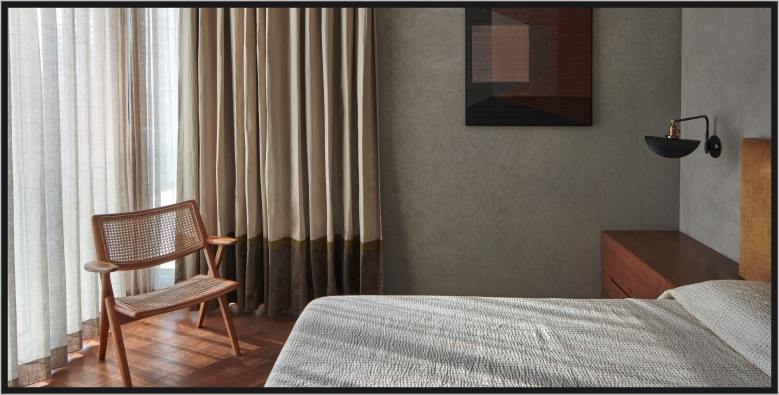
An exemplar of a good client-designer relationship, this 1500 sq. ft. apartment is poetry in minimal design with a focus on materials that blend into each other, allowing for the space to exude a sense of serenity and calm. The concept for Rishi and Ruchi Khajanchi’s apartment originates from a mindset of slow and conscious living, where all things are nurtured and there is a sincere effort to not over-stimulate the senses. The design intent was to create a monolithic space, that allowed for it to appear larger than what it is, a standard challenge of apartments in cities like Mumbai.

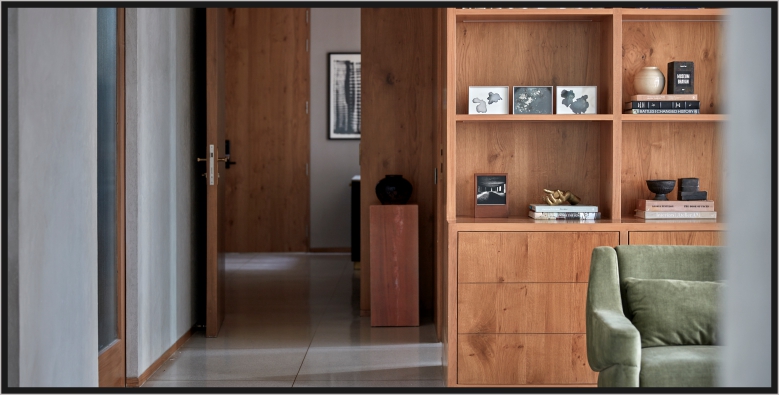
The apartment is a combination of three main materials, i.e. terrazzo, oak, and cement with a series of floor-to-ceiling structures which provide storage throughout the apartment, allowing for it to feel un-cluttered and in turn, visually calming and sparse.
Vazirani feels that the spaces he designs are an extension of what he personally seeks in life – calmness, warmth, and solitude. For this residence, he restricted to a muted material palette, and to allow the materials to flow from one to another seamlessly, so as to avoid any visual clutter. The home linen and upholstery was selected to blend in with the tone of the materials – while colour was only extended to the artwork, and the son’s bedroom.
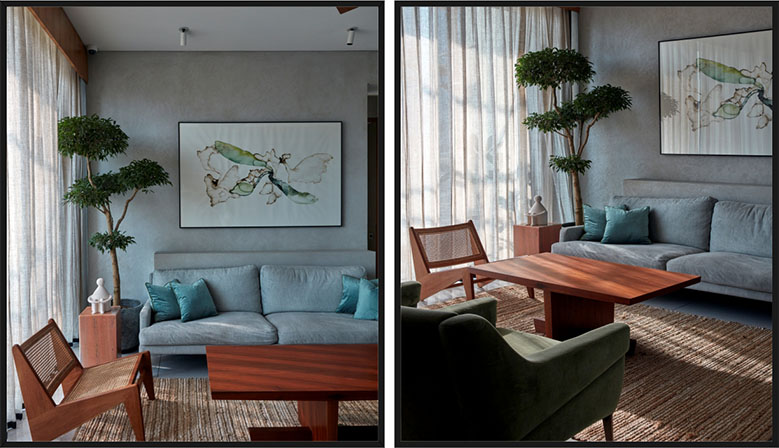
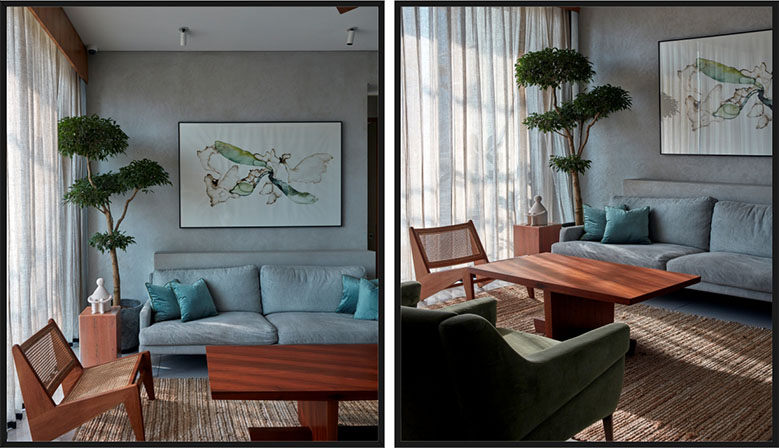
The only burst of colour in the residence is the artwork in the living room by Apnavi Makanji – sourced from Tarq Gallery, and a structured burst of yellow, geometrically aligned with two adjacent walls.
A tactile combination of terrazzo tiles, concrete-finish walls, and lots of natural wood bring materiality and depth into the home. In the living room, a custom designed coffee table is paired with two wooden armchairs, offset by an earthy-hued carpet from Jaipur Rugs. A wood veneer clad floor-to-ceiling shelving unit covers one wall of the room, punctuated with artworks by Dayanita Singh, Aditi Singh, and many others.
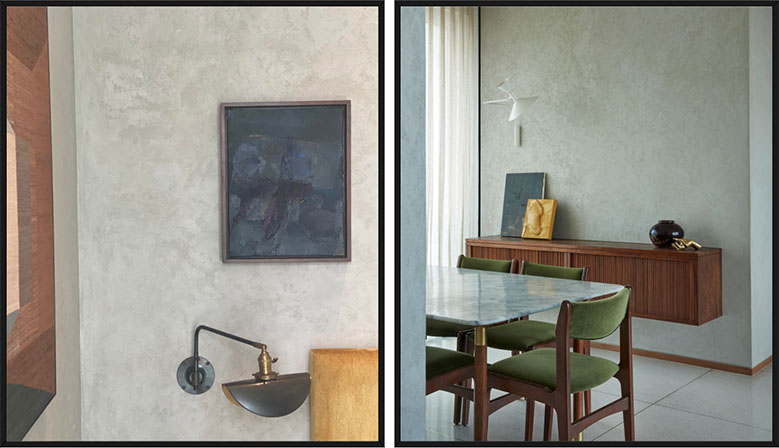
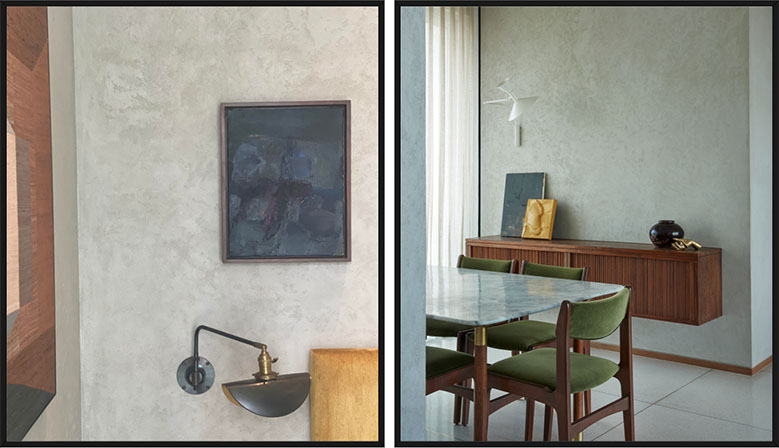
The concrete and terrazzo palette continues into the dining space- dominated by a marble top dining table by Kunal Merchant, with dining chairs custom-made at Vazirani’s studio.
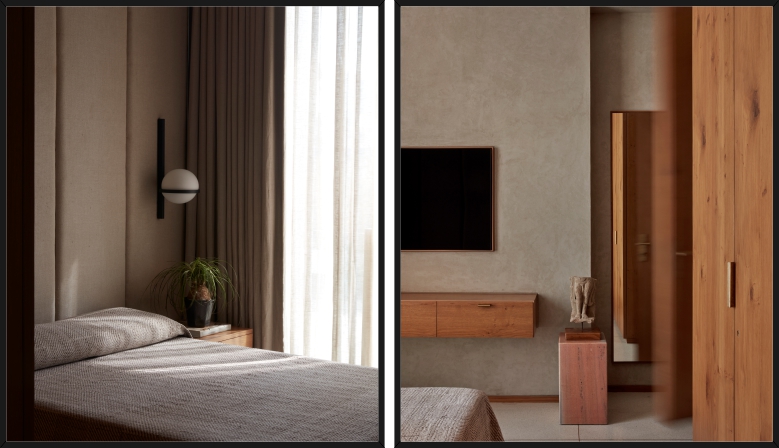
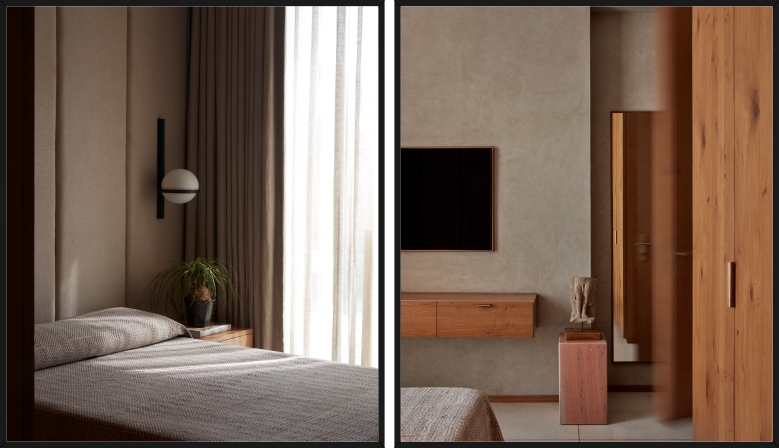
Wood veneer dominates the design in the guest bedroom as well, with a pink stone sculpture curated from Rajasthan adding colour and texture into the space. The wall behind the bed is entirely clad in fabric – showcasing another layer of textures without compromising on the minimalist aesthetic.
The master bedroom exhibits wooden floors, a material that leads from the door into the walk-through wardrobe. The wardrobe in fully mirrored – an infinity space with fluted glass doors leading into the bathroom. The focal point of the bedroom extends from the textile artwork by Netherlands-based studio x + I.

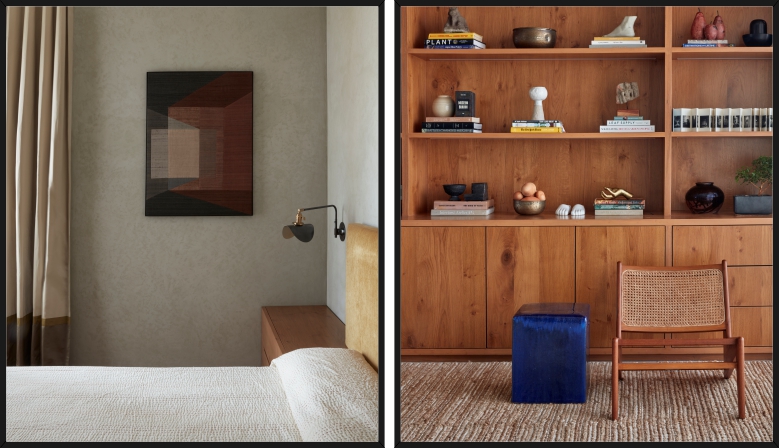
While the rest of the house has terrazzo tile flooring, the master bedroom has wooden floors, a material that carries over to the doorframe that leads into the walk-in wardrobe.
The design of the residence draws from a powerful pool of materials and forms to create a sensorial narrative, even as it reiterates a connection to the homeowners. Over a quick tête-à-tête with The House Of Things, Vazirani outlines the inspiration behind his new collection in collaboration with Ikai Asai, his go-to décor hacks for the festive season, and his top picks from our web boutique.
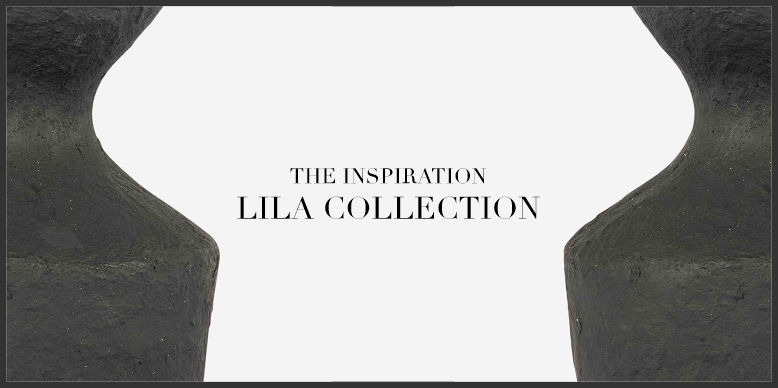
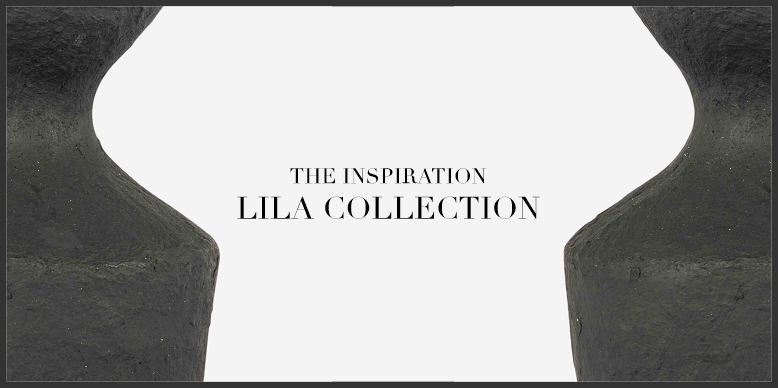
“The inspiration behind the Lila collection was the colours of Pondicherry, the people of Pondicherry and their culture. Since the collection is designed in the peak of the pandemic, I couldn’t physically travel to Pondicherry, hence we used images from travels of other people as a source of inspiration. It forced me to use a different perspective & experience Pondicherry & its culture through a borrowed lens and give it a voice which was our own. As a result, I chose to think of ‘Lila’ as a nomadic entity, who was currently based in Pondicherry, influenced by her surroundings, existing with these pieces.”
